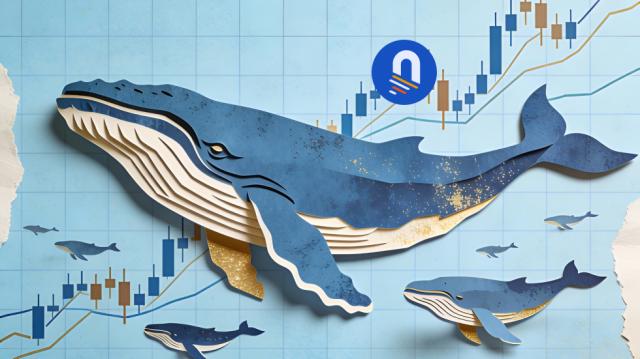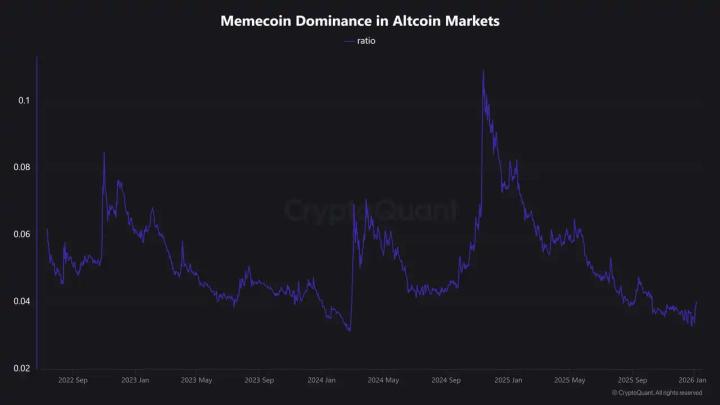Author: Robbie Petersen Source: X, @robbiepetersen_ Translation: Jinse Finance
In the history of cryptocurrencies, the discussion about where value will ultimately accumulate in the blockchain stack has never ceased. The core of the past debate has mainly been between protocols and applications, but there is a third layer in the stack that has been overlooked - the wallet.
The "fat wallet" argument argues that as the protocol and application layers become increasingly "lean", more space will be released to the party with the two most valuable resources - distribution channels and order flow. Furthermore, as the ultimate front-end, I believe no role is better positioned to monetize this value than the wallet.
This article aims to accomplish three goals. First, we will outline three structural trends that will continue to commoditize the protocol and application layers. Second, we will explore the various ways in which wallets can profit from their proximity to the end-user, including payment for order flow (PFOF) and distribution-as-a-service (DaaS). Finally, we will explore why two alternative front-ends - Jupiter and Infinex - may ultimately outcompete wallets in the battle for end-user attention.
Towards a "Leaner" Protocol and Application
The question of where value will ultimately accumulate in the blockchain stack can be boiled down to a simple framework. For each layer of the crypto stack, consider the following question:
If that layer product increases its take rate, will users switch to cheaper alternatives?
In other words, if Arbitrum increases its take rate, will users switch to another protocol like Base, and vice versa? Similarly, at the application layer, if dYdX increases its take rate, will users switch to the next undifferentiated perpetual contract DEX?
Based on this logic, we can identify the layer with the highest switching costs, i.e., who has asymmetric pricing power. Conversely, we can also identify the layer with the lowest switching costs, and thus determine which layer will become increasingly commoditized over time.
While the protocol layer has historically had disproportionate pricing power, I believe this is changing. There are three structural trends that are continuously "thinning" the protocol layer:
Multi-chain applications and chain abstraction: Multi-chain is becoming a basic requirement for applications to remain competitive, and the user experience across blockchains is becoming increasingly undifferentiated, further reducing the switching costs of the protocol layer. Additionally, chain abstraction, which abstracts away cross-chain operations, will further compress switching costs. The result is that applications will no longer depend on the network effects of a single chain, and instead, chains will become increasingly dependent on the distribution capabilities of the front-end.
Maturation of the MEV supply chain: While MEV can never be fully eliminated, there are many initiatives at the application layer and below that are gradually redistributing the amount of MEV extracted from users. Importantly, as the MEV supply chain continues to mature, value will gradually accrue up the MEV supply chain and asymmetrically accumulate to the entities with the most exclusive user order flow. This means the pricing power of the protocol layer will be weakened, while the leverage of the front-end and wallets will be enhanced.
Shift in the proxy paradigm: In a world primarily driven by proxies and "searchers" executing transactions, attracting this proxy flow will become critical to the survival of blockchains. Importantly, since proxies and "searchers" are designed to primarily optimize for best execution, protocols will no longer rely on intangible factors like "vibe" and "consensus", but will compete solely on transaction fees and liquidity - this will further "thin" the protocol layer as protocols will have to compress fees and incentivize liquidity to remain competitive.
Returning to our initial question - if a protocol increases its take rate, will users switch to cheaper alternatives? While this may not be obvious now, I believe that as switching costs continue to compress, the answer will increasingly trend towards "yes".
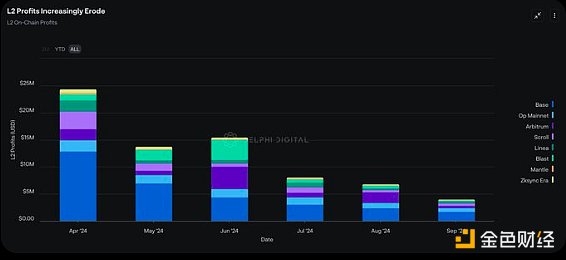
Intuitively, one might think that if the protocol layer becomes "leaner", the application layer will correspondingly "fatten". While the application layer will indeed recapture some value, the "fat application" thesis alone is not enough. Value will accrue in different ways across different application verticals. So the question is not "will applications get fatter?", but "which specific applications will get fatter?"
As I discussed in my "Crypto Moat Identification Framework" piece, the structural differences in crypto applications - forkability, composability, and token-based user acquisition - have the effect of lowering barriers to entry and customer acquisition costs (CAC). Thus, while a few applications may have some unforkable or unsupplantable characteristics, as crypto applications, they still struggle to cultivate moats and maintain market share.
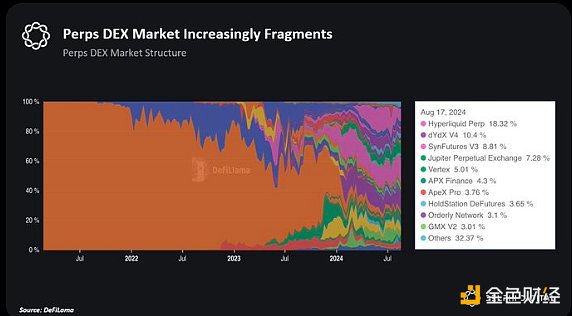
Returning to our initial framework - if an application increases its take rate, will users switch to cheaper alternatives? - I believe the answer is "yes" for 99% of applications. As such, I expect most applications will struggle to capture value, as flipping the monetization switch will inevitably lead to users migrating to the next undifferentiated application offering higher incentives.
Finally, I believe the rise of AI proxies and searchers will have a similar impact on applications as it does on protocols. Given that proxies and searchers will primarily optimize for execution quality, I expect applications will also be forced to compete fiercely for proxy flow. While long-term liquidity network effects may lead to winner-take-all dynamics, in the short to medium term, I expect applications to be embroiled in a price war.
This begs the question - if both protocols and applications continue to "thin", where will the primary locus of value accumulation be?
The "Fat Wallet" Thesis
In short, value will accrue to the party that owns the end-user. Theoretically, this could be any front-end application, but the "fat wallet" thesis argues that no one is better positioned than the wallet. There are five sub-theses supporting this logic:
1. Wallets dominate the crypto mobile user experience: On mobile, a good way to understand who owns the end-user is to ask "which Web2 app will the user ultimately interact with?" While most users transact through the Uniswap front-end, the entry point for them is their crypto wallet app. This means that if mobile increasingly dominates the crypto user experience, wallets may further cement their relationship with the end-user, becoming a critical application access point.
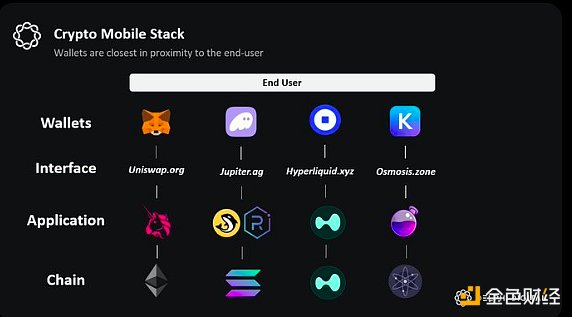
2. Wallets "natively" satisfy user needs: Crypto applications are fundamentally financial applications. Unlike Web2, nearly all on-chain transactions are some form of financial transaction. Furthermore, the account layer is critical to crypto users. Additionally, the wallet layer also has some unique synergistic features like payments, native yield on idle balances, automated portfolio management, and other consumer-facing use cases (e.g., crypto debit cards). For example, Fuse is leading in this regard, offering features like Fuse Earn and Fuse Pay, which allow users to spend their wallet balances using a Visa debit card in the real world.
3. Wallets have unexpectedly high switching costs: While theoretically switching wallets only requires copying and pasting a seed phrase, for most ordinary users, this is a psychological barrier. Given that users implicitly bestow a high degree of trust in wallet providers, I believe brand and "reliability" are a powerful defensive moat for the wallet layer. Returning to our initial question - if a product in the stack increases its take rate, will users switch to cheaper alternatives? - in the case of wallets, the answer seems to be "no"; MetaMask's 0.875% fee on in-wallet swaps is an embodiment of this logic.
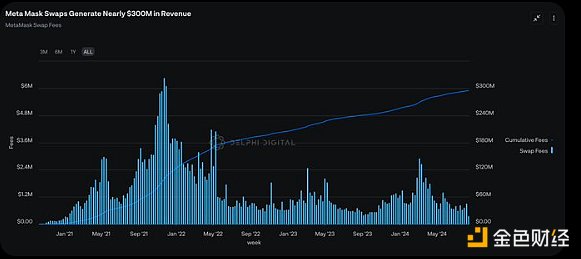
4. Cross-chain abstraction: Although cross-chain abstraction is a technically complex issue, the wallet layer provides an attractive solution. The idea of accessing cross-chain applications through a single account balance is intuitive and convenient. Projects such as @OneBalance_io, @BrahmaFi, @Polaris_App, @ParticleNtwrk, @Ctrl_Wallet, and Coinbase's smart wallets are all working towards this direction. In the future, more teams will meet user demands by solving cross-chain abstraction at the wallet layer.
5. Unique synergy with AI: Although AI agents may further commoditize other parts of the blockchain stack, users still need to authorize agents to ultimately execute transactions on their behalf. This means the wallet layer is best suited to become the standard frontend for AI agents. Other low-barrier entry points for integrating AI at the account layer include automated staking, yield farming strategies, and customized user experiences enhanced by large language models (LLMs).
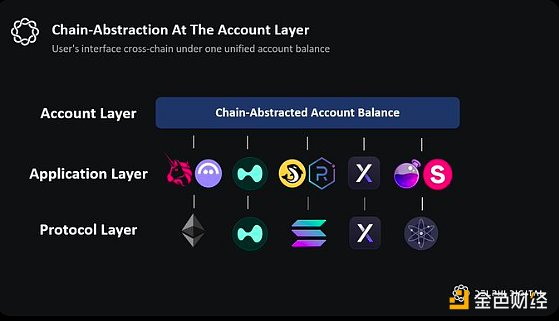
Now that we have outlined the "why" of wallets increasingly owning the end-user relationship, let's think about how they will ultimately "monetize" this relationship.
Monetization Opportunities
The first monetization opportunity for wallets lies in the ownership of user order flow. As mentioned earlier, while the MEV supply chain will continue to evolve, value will continue to disproportionately accrue to those with the most exclusive access to order flow.
Currently, the frontends that own the majority of order flow are solvers and decentralized exchanges (DEXes). But this chart alone lacks nuance. It's important to understand that not all order flow is created equal. Order flow can be divided into two types: (1) fee-sensitive flow and (2) fee-insensitive flow.
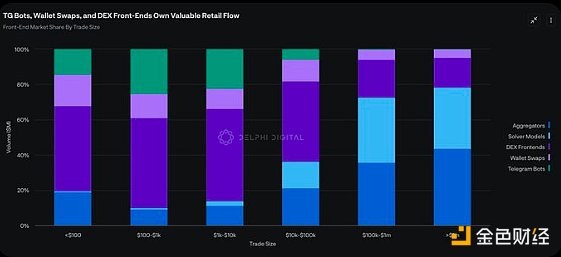
Generally, the solver model and aggregators dominate the "fee-sensitive" flow. These users typically trade amounts over $100,000, so execution is very important to them. They won't accept an extra fee of more than 10 basis points. Therefore, "fee-sensitive" traders are the lowest-value customer segment - although by volume they own the majority of the market, the value generated per $1 of trade is far lower than other channels.
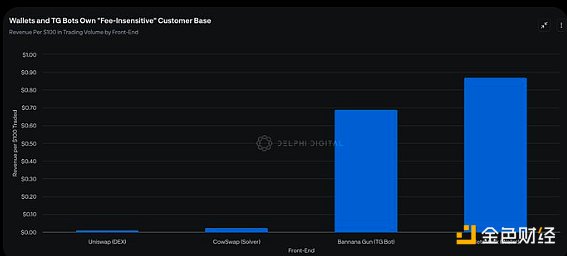
In contrast, wallet swaps and Telegram trading bots have a more valuable user base - "fee-insensitive" traders. These traders pay for convenience rather than execution fees. So paying 50 basis points in a trade doesn't matter much to them, especially when they expect the trade outcome to be 100x or zero. As a result, Telegram bots and wallet swaps generate revenue per $1 of trade volume that is nearly 100x higher than DEX frontends.
Going forward, if wallets can leverage these trends and continue to maintain the relationship with end-users, I expect wallet-native swaps to continue to cannibalize market share from other frontends. More importantly, even a 5% increase in their market share would have a massive impact, as wallet swaps generate nearly 100x the revenue per $100 of trade volume compared to DEX frontends.
This brings us to the second opportunity for wallets to profit from their proximity to end-users - Distribution-as-a-Service (DaaS).
As the standard frontend for user on-chain interactions, app distribution ultimately depends on wallet providers, especially on mobile. Wallets thus seem well-positioned to strike exclusive deals with apps in exchange for distribution support. For example, wallet providers could build their own app stores and charge apps through revenue-sharing agreements. MetaMask appears to be exploring a similar direction with the launch of "snaps".
Similarly, wallet providers can also direct users to specific apps and share in the economic benefits. This has an advantage over traditional advertising in that users can directly make purchases and interact with the app from within the wallet. Coinbase has been experimenting with this by promoting "featured" apps and in-wallet quests to guide users.
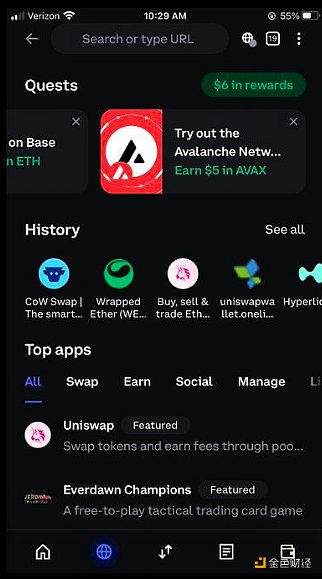
Wallets can also help onboard users to emerging chains by sponsoring user transactions. For example, if Bearachain wants to attract users to its chain, they could pay MetaMask to sponsor cross-chain fees and gas fees on Bearachain. Given that wallets ultimately own the end-user, I expect them to be able to negotiate favorable terms.
As more users onboard through wallets as the primary on-chain access point, we may see a shift in demand from "block space" to "wallet space", as attention becomes the most valuable resource in the crypto economy.
Ambitious Consumers Face Formidable Challenges
Finally, while wallets have an advantage in the race for end-user ownership, I remain excited about the prospects of two alternative frontends:
Jupiter: @JupiterExchange, by starting with a DEX aggregator as the initial entry point, has built a strong relationship with end-users, giving it one of the best starting positions in crypto to expand into other related products, including its perpetual contract DEX, launchpad, native LST, and the latest RFQ/solver offering. I'm particularly excited about Jupiter's upcoming mobile app, as this could push its mobile user relationship position ahead of wallets, closer to the end-user.
Infinex: @Infinex_App, by integrating apps across EVM chains and Solana, Infinex aims to maintain non-custodial and permissionless principles while providing a CEX-like experience. Infinex will initially offer spot trading and staking, and plans to integrate perpetual contracts, options, lending, leveraged trading, yield farming, and fiat onramps. By abstracting the account layer and using Web2-familiar features like password keys, I believe Infinex also has the potential to replace wallets as the standard frontend for crypto.
While it's still unclear who will ultimately win the battle for end-user ownership, it's increasingly evident that (1) user attention and (2) exclusive order flow will continue to be the scarcest and most monetizable resources in the crypto economy. Whether it's wallets or alternative frontends like Infinex or Jupiter, I expect the most valuable projects in the crypto space going forward to be those that own these two key resources.




